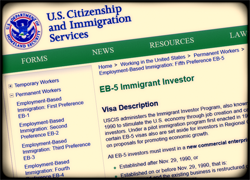If you step back a metaphorical 100 yards and put your mind in neutral, you might notice that the EB-5 (immigrant investor) program is refreshing and different in one strange way: It is the only government program that I know of that routinely treats the rich as powerless riffraff.
It's not that the government puts workers first, or even taxpayers; the tilt is toward another set of "haves", the middlemen who profit from the money invested by the aliens. (There may be some indirect benefits to others, but the middlemen are the most likely to get something out of this program.)

Or as Peter Elkind put it a little more gently in his Fortune essay on the program:
[T]he EB-5 industry is virtually unregulated, it has become a magnet for amateurs, pipe-dreamers, and charlatans ... perhaps because wealthy foreigners are the main potential victims, U.S. authorities have seemed inattentive to abuses.
This is not to suggest more protections for those seeking to buy green cards for half a million dollars a set. The policy change needed is the termination of the program.
One rather casual element of Elkind's article, a photo caption, led me to these thoughts. The picture was of the Jay Peak resort in upstate Vermont, where a lot of EB-5 money has been invested. Elkind reports that it will take 11 years for the alien to get "full payment" for his or her investment.
With this time-span in mind, I decided to compare the return on two different investments over a period of 11 years. In both cases, for the sake of simplicity, I assumed no other fees (as there always are in EB-5), no inflation, and full repayment in a single lump sum at the end of the 11 years.
the EB-5 Visa Program:
Were one to simply buy a US Treasury note for $500,000, one would gain about $152,000 in interest in those 11 years. If, on the other hand, one used the money to buy an EB-5 investment at Jay Peak and got back only the original investment after 11 years, with no interest, one would have lost $152,000. (The yield yesterday for the 10-year Treasury note was 2.44 percent.)
I have been paying close attention to the EB-5 program for three years now and I have read everything I could find. I have been, among other things, looking for a particular form of success story, and if it is out there I am sure someone would have publicized it. The success story I am missing is a tale of an EB-5 investor getting all of his or her money back.
In the case of Jay Peak, we do not have such an account, but we do have a promise of full repayment after 11 years, after the loss (as I calculate it) of $152,000 in interest.
All of this simply buttresses what the critics have been saying about this program: the aliens do not make these often marginal investments for financial gain. Rather, they do it for the family-sized set of green cards that they obtain.
The since-terminated Canadian immigrant investor program treated both the aliens and that nation's taxpayers better. At the end of five years (not 11) the alien was guaranteed his money back – it had been lent to one of the provinces – and the taxpayers would benefit because the loan was interest-free.
